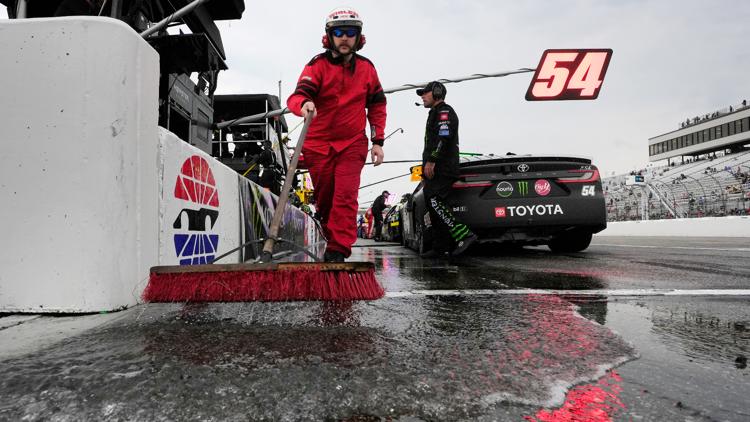LOUDON, N.H. — After decades of races shortened or delayed by sprinkles or severe storms, NASCAR may have finally mastered the art of racing in the rain.
Well, at least on a damp track.
Christopher Bell drove the final 86 laps Sunday at New Hampshire Motor Speedway to become the first driver in the Cup Series to win a race on Goodyear rain tires.
It was a race Bell wouldn't have won before this season — New Hampshire was stopped by rain with 82 scheduled laps left and it would not have resumed without the wet-weather tires. That would have meant a checkered flag for Tyler Reddick.
Bell instead celebrated his second career Cup win at New Hampshire once the race resumed on the new tires and swept the weekend following his Xfinity Series win on Saturday.
“We would have been done with 82 laps to go,” senior vice president of competition Elton Sawyer said. “It gave us an opportunity to get that green.”
NASCAR switched to wet-weather tires Sunday after a 2 hour, 15-minute weather delay that threatened to end the race. New Hampshire had a solid crowd for its lone Cup weekend and fans that braved the weather and stuck out the delay were treated to a thrilling — and complete — race to the end because of the tires.
“Our fans that bought a ticket, they got to see some great, exciting racing,” Sawyer said. “There are still some things that we’re learning through this process.”
The Xfinity Series also used the wet-weather tires on Saturday.
Bell, team owner Joe Gibbs and crew chief Adam Stevens all had rave reviews for the tires.
“I was probably the biggest skeptic when they said they wanted to run wet at the ovals,” Stevens said. “I thought they were crazy. They proved me wrong, for sure. They did a really good job of coming up with a plan methodically. They figured out that once you got the water off the race track, you could run in it. That was probably the best way to dry the track, too.”
Sawyer said the idea to move ahead with Goodyear for a reliable rain tire was the vision of NASCAR chairman Jim France. The tires weren't constructed to be used when it's actually raining but once the severe weather has passed and the oval tracks are still damp. Teams had a maximum of four sets of wet-weather tires to race on the damp oval track. Teams had to take rain tires during pit stops and their position could not be affected.
NASCAR used non-competitive pit stops because pit road was not completely dry.
“We just want to do this in the safest way possible,” Sawyer said.
NASCAR only used a wet-weather tire once before on an oval in a Cup race — at the start of this season's race at Richmond that saved it from a lengthy delay.
“If you look at the reason we came up with this and started working with teams and the folks at the (research and development center), it was to do exactly what we did yesterday with the Xfinity race and what we did today with the Cup race,” Swayer said. “So yes, very successful.”



